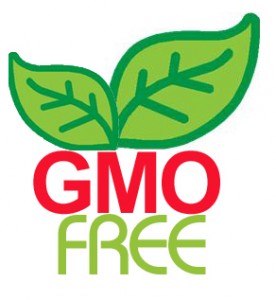by Eric Fairwind
Member, Gabriolans for Local Food Choices
Reprinted with permission
This October has been designated the first ever Non-GMO Month.
The Campaign for Healthier Eating is designed to achieve the tipping point of consumer rejection of genetically modified foods in the US and Canada. The campaign begins October 10, 2010 and runs until November 11, 2011. We hope you’ll be part of this North American movement.
Everyone has the right to an informed choice about what they eat. In Europe, all products containing more than 0.9% GMO are labeled by the government. But in the US and Canada, government has obstructed giving consumers information about which food and products contain GMOs, by not allowing the labeling of GMO food. It is estimated that GMOs are now present in more than 75% of the processed foods in the average grocery store.
Many people are concerned about the potential health risks of products made using the technology of genetic modification. In fact, the American Academy of Environmental Medicine has called for a moratorium on GMO foods, long term safety testing, labeling, and education of their patients concerning the consumption of GM foods. They state that several animal studies indicate serious health risks associated with GM food consumption including infertility, dysregulation of the immune system, cholesterol synthesis & insulin , accelerated aging, changes in the liver, kidney, spleen and gastrointestinal system. More independent scientific studies around the world are finding similar startling results.
A large and growing body of scientific research and on-the-ground experience indicate that GM crops:
- Can be toxic, allergenic or less nutritious than their natural counterparts.
- Can disrupt the ecosystem, damage vulnerable wild plant and animal populations and harm biodiversity.
- Increase chemical inputs (pesticides, herbicides) over the long term.
- Deliver yields that are no better, and often worse, than conventional crops.
- Cause or exacerbate a range of social and economic problems such as forcing farmers to pay exorbitant prices for seeds and then paying them poorly for their crops, feeding in to a far-away industrial food system, and causing farmer suicides in India from an inability to pay for GM seeds & chemicals.
- Are laboratory-made and, once released, harmful GMOs cannot be recalled from the environment.
- Degrade the topsoil, destroying valuable nutrients in the soil.
- Pollute groundwater by chemicals used in GM agriculture.
Most vegetables and fruits are not genetically modified, with the exception of Hawaiian papaya (more than 50%), and a small amount of alfalfa, zucchini, yellow crookneck squash and tobacco.
When buying packaged food, be sure to keep a lookout for common GMO ingredients such as: corn oil, corn syrup, corn starch, soy protein, soy oil, soy sauce, lecithin, cottonseed and canola oil. If your package lists one or more of these ingredients, these foods are genetically modified, unless labeled organic or non-GE (non-genetically engineered).
What crops are most often GMOs?
- SOY (89%)* Chocolates use soy lecithin; Breads use soy flour; Shakes use soy protein concentrate; Baby formulas use soy milk.
- CORN (61%)* High fructose corn syrup is found in sodas, cereals, cookies, candy, salad dressings, spaghetti sauces, and 1,000 other products. Baked goods use cornstarch; Vegetable oils use corn oil; Breads use corn flour.
- CANOLA (80%)* Fried products use canola oil; Baked goods use canola oil; many health products use canola oil.
- COTTON (83%)* Chips use cottonseed oil; Fried snacks use cottonseed oil.
*Percentage of GM soy, corn and cotton in the US and GM canola grown in Canada.
For more extensive lists of GM ingredients found in food please visit Seeds of Deception and the Non-GMO Shopping Guide.
Please join us in making safer buying choices and not buying genetically modified foods.
For additional information on the GMO issue, visit the Non-GMO Project.
 I’m pleased to learn there is a movement in British Columbia to actively oppose GMO crops. Edible Vancouver reports that earlier this year 51 municipalities supported a motion to make Vancouver Island and Coastal Communities free of genetically engineered crops. Now we just need to make that forward-thinking motion move right on into legislation.
I’m pleased to learn there is a movement in British Columbia to actively oppose GMO crops. Edible Vancouver reports that earlier this year 51 municipalities supported a motion to make Vancouver Island and Coastal Communities free of genetically engineered crops. Now we just need to make that forward-thinking motion move right on into legislation.